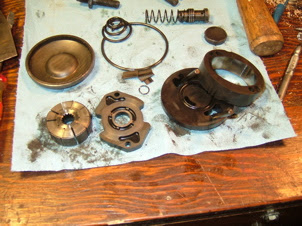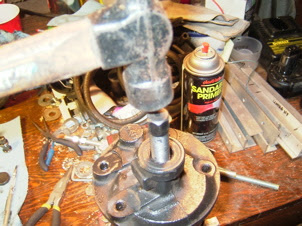Here's how I wired the TBI, based on information from Binder Planet and other sources.
Sources:
Sources:
Original Wiring
The OEM wiring for the Duraspark is shown below where the ignition module has a two-pin connector and a four-pin connector.
Two-pin connector:
- Yellow wire is hot when the ignition switch is at ON or START positions. Powers the module.
- Green wire is hot when the ignition is at START position. Tells module to retard timing at startup
Four-pin connector
- Violet and Orange wires are from the distributor pickup coil
- Black wire is the pickup coil ground
- Green with tracer (stripe) is the coil negative terminal; the module controls spark with this wire
Notice that a ballast resistor is used to drop the coil voltage to 9V when the vehicle is running (ON), but this resistor is bypassed with a 12V signal from the starter solenoid when cranking (START).
GM TBI Wiring
The GM TBI system I'm installing uses an 8-pin ignition module. The 8-pin module has two pins for the distributor pickup coil, P and N, a connection for power, "+" (hot in START and ON), a negative coil connector, "C", a ground, and four wires that connect to the ECM.
 |
| GM HEI 8-Pin Ignition Module Wiring Diagram for TBI |
The GM system expects a more modern coil as well, one that is powered by 12V at all times versus the OEM coil that needs 9V during regular running and 12V at start.
Duraspark to GM 8-Pin HEI Wiring
Combining these two diagrams, that is, replacing the Duraspark Ignition Module with the GM HEI 8-Pin Ignition Module, eliminating the ballast resistor to give the coil 12V at all times, we get the following:
 |
| Replacing the Duraspark module with GM 8-Pin HEI module |
- GM 8-pin module P pin connects to FSJ Light Blue (connects to distributor Violet)
- GM N pin to FSJ White (connects to distributor Orange)
- GM module + (Pink with trace) to FSJ Yellow wire (Duraspark power, ON, START)
- GM Pin C (Green) is connected to FSJ Green w/ Trace, to the negative coil.
- GM ground is connected to distributor ground, FSJ Black.
- Pins G, B, R, E go to the ECM, a subject for another article.
FSJ Duraspark wire colors varied across the years. Hopefully I've provided enough information for you to figure it out for your particular Duraspark model.
Installation
I removed the Duraspark module off the FSJ. For now, I wanted to re-use the OEM Duraspark Ignition Module connectors. Later I will convert to Weatherpack connectors.
I cut a set of connectors off of one of my dozen spare modules that I'll never need again. I spliced the wires from these connectors to the GM 8-Pin HEI module and then plugged everything in.
Wire colors on different modules vary. These connectors use Red for module power, White for start (not connected), Black w/ Trace for ground, Green for Coil negative, Violet and Orange for Pickup coil.
 |
| GM 8-Pin HEI Ignition Module is wired into OEM connectors |
On the CustomEFI kit I bought a long tim ago, much of the wiring complexity is simplified as it comes with a really simple to use harness. For example, the red wire above connects to a relay or two, the computer, and the module already. All I have to do is hook up the red wire to the FSJ yellow providing power when the ignition switch is in ON or START positions.
Wire Splicing Tips
For a high quality, reliable splice, I used solder, heat shrink, and automotive butt connectors (blue or red as appropriate for wire gauge). First, I carefully cut off the blue/red case with a utility knife; a cut lengthwise to split the case in half and push the metal connector out (you can buy these connectors without the case, too). I cut a length of heat shrink tubing slightly longer than the butt connectors and slid it over one of the two wires to be joined. I stripped the wire ends, dipped them in flux paste, then inserted and crimped them into the butt connector. Next, I soldered the butt connector and wires with rosin core solder. Finally, I slid the heat shrink over the joint and heated it up (a lighter works but I prefer a heat gun). And, voila, a highly reliable, soldered, insulated wire splice.









































 , an hour or less, and these instructions.
, an hour or less, and these instructions.









